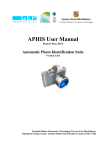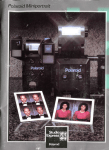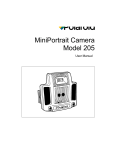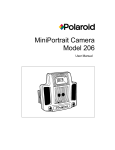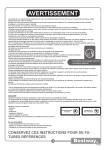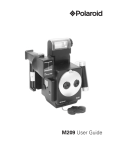Download Polaroid 203 Film Camera User Manual
Transcript
MiniPortrait Camera Models 203/403 User Guide Model 203 Miniportrait 203/403 Camera User Guide • Film processing timer on the back of the film holder. The numbers throughout the text refer to the pictures at the back of this User Guide. Camera parts (Picture1) A. Electronic flash unit B. Polaroid pack film holder Model 73A C. Shutter button D. Viewfinder E. Camera controls: Camera on/off switch Distance selector Lens aperture selector Shutter speed selector Portrait selector Portrait counter Socket for remote shutter release Socket for AC adapter X (sync) socket Introduction The Polaroid Miniportrait/Studio Express Cameras are designed to meet a variety of photo-identification needs. There are two different camera models. The Model 403 produces four portraits on each sheet of Polaroid 31/4 x 41/4 in. (8.5 x 10.8 cm) instant pack film; the Model 203 produces two portraits on each sheet. F. G. H. I. J. K. L. Sonar rangefinder transducer Tripod socket (on bottom of camera) Lenses Battery compartment (inside hand grip) Hand grip Flash tilt knob Flash controls (on back of flash unit): Ready light Film speed selector M. Flash sync adapter The basic operation is the same for both models; the Model 403 is featured here. The Model 203 is shown wherever there are important differences in operation. • Portrait combinations: Model 403 produces 4 identical portraits, 2 pairs of identical portraits or 4 different portraits; Model 203 produces either 2 identical or 2 different portraits. Accessories • Available films: Color prints, black & white prints or black & white prints with usable negatives. • Built-in electronic flash unit; the camera also can be used with other types of lighting. • Sonar rangefinder, to ensure that the camera is at the correct distance for sharp focus and correct image size. Remote Shutter Release (2): 1 m (approx. 39 in.) long; allows the photographer to move around and work closely with the subject while taking pictures. (PID# 612412) Supplementary Lenses 78 (3): Produce a smaller subject size, allowing you to include more than one person in each portrait. (PID# 600272) 2 Miniportrait 203/403 Camera User Guide OR WITH WET HANDS. IF SERVICE OR REPAIR WORK IS REQUIRED, CONTACT AUTHORIZED SERVICE CENTER. INCORRECT REASSEMBLY CAN CAUSE ELECTRIC SHOCK WHEN UNIT IS USED SUBSEQUENTLY. 7. CLOSE SUPERVISION IS NECESSARY WHEN UNIT IS USED BY OR NEAR CHILDREN. 8. THE USE OF ACCESSORIES OTHER THAN THOSE RECOMMENDED MAY CAUSE RISK OF FIRE, ELECTRIC SHOCK OR INJURY. Film Holder 73A: This holder is shipped with the Model 403 camera; additional holders can be loaded with different film types for easy interchangeability. (PID# 612413) Film Holder 73B: Allows use of a validation plate. (PID# 612414) Film Holder 73C: This holder is shipped with the Model 203 camera; it is identical to the 73A film holder except for the location of the timer. (PID# 612415) Underwriter’s Laboratories, Inc. (U.L.) requires that the following safety information be provided. PLEASE KEEP THESE INSTRUCTIONS. IMPORTANT SAFEGUARDS Validation Plate (4): For use with the 738 film holder; plate may be custom-printed for more secure identification pictures. (PID# 612410) AS WITH ANY ELECTRICALLY OPERATED EQUIPMENT, BASIC SAFETY PRECAUTIONS SHOULD BE OBSERVED. REMEMBER: AC Adapter (5): Enables the camera to use electrical power, rather than batteries. Important: The use of other AC adapters may damage the camera. (PID# 612411 for 120-volt supply, PID# 612427 for 220volt supply, PID# 612698 for 240-volt supply, PID# 612559 for 100-volt supply) 1. FOLLOW ALL INSTRUCTIONS. 2. DO NOT LEAVE UNIT UNATTENDED. 3. IF UNIT WILL NOT BE USED FOR EXTENDED PERIOD OF TIME, REMOVE BATTERIES; IF USING AC ADAPTER, UNPLUG UNIT FROM ELECTRICAL OUTLET. GRASP PLUG, NOT CORD, AND PULL TO DISCONNECT FROM OUTLET. 4. DO NOT OPERATE UNIT WHICH HAS BEEN DROPPED OR DAMAGED, UNTIL IT HAS BEEN EXAMINED BY AUTHORIZED SERVICE CENTER. 5. BEFORE STORING, ALLOW UNIT TO COOL COMPLETELY. 6. TO AVOID ELECTRICAL SHOCK HAZARDS, DO NOT IMMERSE UNIT IN WATER OR OTHER FLUIDS. DO NOT OPERATE UNIT NEAR WATER Auxiliary Camera Sync Cord (6): Allows a second camera to be synchronized with the camera. (PID# 612409) Flash Sync Adapter: The adapter is shipped with the camera. It is designed to reverse the polarity of an external flash unit, to make it compatible with the camera’s built-in flash. (PID# 613249) The accessories are available from your Polaroid Camera Dealer, or contact the nearest Polaroid Office. 3 Miniportrait 203/403 Camera User Guide batteries and store them separately, to prevent damage caused by leaking batteries. Load the batteries The camera uses four 1.5 volt AA batteries, which provide power for the shutter, electronic flash unit and sonar rangefinder. Alkaline batteries are recommended. Do not use NiCad rechargeable batteries; they may damage the camera. A set of batteries is included with the camera. Note: An AC adapter may be preferred for high-volume use (see Accessories). Model 73A film holder (9) A. Dark slide B. Door latch C. Film tab slots D. Camera mounting brackets E. Film developer rollers F. Timer (on back of holder) A fresh set of alkaline batteries should last for approx. 80 flashes. The flash unit should recharge in 10-12 sec. with fresh batteries; when the recharge time reaches 30 sec., replace the batteries. The battery compartment is inside the hand grip. Open the lid (7) and insert the batteries in the orientation shown inside the compartment (8). Then close the lid. Load the film The holder may be loaded either before or after it is attached to the camera. If the holder is not attached to the camera, check that the dark slide is fully inserted, to prevent fogging the film. If the camera will not be used for an extended period of time, remove the Polaroid 3% x 4% in. (8.5 x 10.8cm) pack films Film type Speed (approx. IS0 equiv.) Description Type 669/108 Polacolor ER 80/20o This film yields a positive color print. It is balanced for use with electronic flash or in average daylight (5500°K). With its extended tonal range and lower image contrast, it is ideally suited for portraiture. Type 668 Polacolor 2 80/20o Similar to Polacolor ER film (above) except that it produces a higher-contrast print. Type 107 High-speed 3000/36o A very high speed black and white film, which yields a positive print. Type 667 High-speed 3000/36o Same as the above, but prints need not be coated after processing. Type 665 Pos/Neg 80/20o A black and white film which produces a high-quality negative, in addition to the positive print. 4 Miniportrait 203/403 Camera User Guide Pull both sides of the latch to open the door; the door does not open flat. Before loading the film, check that the developer rollers are clean (see Clean the developer rollers). To load/change the timer batteries: If the display or tones fade, or if the timer stops functioning, the batteries should be replaced. The timer uses two 1.5 volt GP-89A (or equivalent) batteries. Always hold the film pack by the edges, not in the center. Slide the pack in at an angle (10), then push it down into place. Check that the white tabs are not caught between the pack and the holder (11). Close and latch the door, with the end of the black tab sticking out. Slide the battery cover open (15) and insert the batteries as shown. Then replace the cover. Always press the SET and START buttons simultaneously after replacing the batteries. Pull the black tab straight, all the way out of the holder (12). A small white tab will appear. Generally the holder is attached so the film tab slots face down (Model 403), or to the right (Model 203) The holder is now loaded. Attach it to the camera, if you have not done so already. Place the holder against the back of the camera, making sure that it is properly seated. Then engage both sliding locks, to grip the holder firmly (16). Attach the holder to the camera No white tab? Open the door and, without moving the film pack, push the white tab out (13). Then close and latch the door. Camera location Set aside an area for photography, so the camera, backdrop and subject’s chair need not be continually rearranged. The film processing timer To set the timer (14): Press and hold the SET button until the correct processing time is displayed (see the film instructions for recommended times). The timer will always return to this setting after a processing cycle. Use a tripod The camera should be mounted on a sturdy tripod, with a rising center post (17). Orient the camera so that the tripod’s adjustment levers will not obstruct the film tabs as they are pulled out of the camera. To reset the timer to a new time: To reset it to a longer time than is displayed, simply press and hold the SET button until the new time is displayed. To reset it to a shorter time: The tripod socket has a removable thread converter (18); if your tripod has a larger fastening screw, remove the converter. 1. Press the SET and START buttons simultaneously. The preset time is cancelled and zero is displayed. 2. Press and hold the SET button until the new time is displayed. 5 Miniportrait 203/403 Camera User Guide Seating the subject (19) The electronic flash A seat should be provided for the subject. Avoid chairs with high backs, which may appear in the picture. Adjust the height of the camera so that the lenses are about level with the eyes of the seated subject. The flash unit is designed to provide even illumination and proper exposure. To turn on the flash, simply raise the flash head all the way (22). The flash turns off when the head is tilted down. The flash reflector should be pointed directly toward the subject. Seat the subject close to the background, to ensure a light background and also the smallest possible shadow behind him. Note: The camera’s shutter and rangefinder will not work while the flash is recharging; they will work only if the flash is of for ready. The operating distance The distance from the front of the camera to the eyes of the subject should be 1.2m (47 in.). When using the Supplementary Lenses 78, the correct camera-to-subject distance is 1.92m (76 in.) (See also Appendix: Depth of field.) The camera also can be used with other types of lighting (see also Appendix: Alternative lighting techniques). The sonar rangefinder The sonar transducer on the front of the camera emits sound waves, which bounce off the subject and return as echos. The transducer measures the time it takes for the echo to return, and calculates the distance from the camera to the subject. Turn on the camera Push the switch to “1” to turn on the power for the camera’s shutter, rangefinder and flash unit (20). Set the camera controls Important: Be sure the sound waves from the transducer have a clear path to the subject. Distance: Set the switch to 1.2 or 1.92m (20); this sets the rangefinder for the desired distance. Film speed: Set the switch to 80 or 3000 (21); this sets the flash for the correct amount of light. To use the rangefinder, look through the viewfinder and press the shutter button halfway. If the camera is at the correct distance, both lights will be on (23). Lens aperture and shutter speed (20): Use the guidelines on the back of the flash unit (21), and set as indicated. If the camera is too close, the left-hand light will be on; if too far, the right-hand light will be on. If the camera is mounted on a tripod, use the rangefinder only when setting up for the day’s photography. It is not necessary to check the distance for every portrait, although you may want to check occasionally while shooting. 6 Miniportrait 203/403 Camera User Guide Important: Whenever the portrait selector is changed to a different setting, the camera must be reset as described above, to prevent possible double-exposures. If the camera is hand-held, use the rangefinder for each portrait, to ensure that all subjects are at the correct distance. Note: The rangefinder will not work while the flash is recharging: it will work only if the flash is off or ready. (See also Appendix: Depth of Field.) Model 203: Slide the portrait selector to the desired setting. It is not necessary to reset the counter and shutter. The Viewfinder Taking the picture When the camera is 1.2m (47 in.) from the subject, frame the subject within the full frame (23-A). When at 1.92m, use the partial frame (23-B). 1. Remove the dark slide from the film holder (26). 2. Check that the flash ready light is on. The camera’s rangefinder and shutter will not work while the flash is charging. The viewfinder of the Model 203 camera also contains a bar and three dots. These are used when the subject’s face must be a specific size in the finished portrait. 3. Frame the subject in the viewfinder. If the camera is hand-held, press the shutter button (27) halfway to check that the camera is at the correct distance. The portrait selector and counter The portrait selector (24) can be set for different portraits, identical portraits or 2 pairs of identical portraits (Model 403). The portrait counter (25) shows the next portrait or pair of portraits (Model 403). If the selector is set for identical portraits, the counter always reads “1”. 4. Press the shutter button all the way to take the picture. Processing the film Model 403: Pull the film tabs straight down (28). If necessary, brace the camera while pulling. Model 403: Slide the portrait selector to the desired setting. Then set the counter and electronic shutter as follows: Model 203: Hold the camera firmly by the hand grip, while pulling the film tabs straight out (29). 1. Turn off the flash. 2. Make a “blank” exposure: Push in the dark slide (to avoid wasting film), then press the shutter button all the way down. 1. Pull the white tab straight, all the way out of the camera. A large yellow tab will appear. If not, see No yellow tab? 2. Pull the yellow tab: Grip the tab firmly, and pull it straight, at moderate speed, without hesitation, all the way out of the camera (30). 3. Turn the wheel (25-C) in the direction of the arrow so “1” is visible in the window. 7 Miniportrait 203/403 Camera User Guide nor with your fingernail, and never attempt to disassemble the rollers. Also clean the film tab slot (36). Then replace the roller assembly. 3. Start the timer. The correct processing time should already be set. Press the START button once; the timer will count down to zero. At the end of the processing time, a series of short tones will sound. The timer will reset for the next picture. Picture faults and probable causes Repeated, evenly-spaced spots: Due to dirt on the steel rollers in the film holder. 4. Process the picture for the full time recommended in the film instructions. Then separate the print from the negative, starting at the end nearest the yellow tab (31). Information on handling of prints and negatives is in the film instructions. See Caution notice. Missing corners or orange-red marks along edges: Caused by pulling the yellow tab out of the camera at an angle. Oblong in print: The white tab was not pulled all the way out. When the yellow tab was pulled, that white tab was pulled back into the camera. No yellow tab? Do not pull another white tab. Instead, carefully open the holder far enough to get a finger on top of the film pack to hold it down (32). Grasp the top most yellow tab, and gently pull it all the way out and discard it (33). Inspect the rollers and clean them if necessary (see Clean the developer rollers). Close and latch the holder, with the next white tab sticking out. (You will have to reshoot the portraits that were on that piece of film.) Many small white specks: Caused by pulling the yellow tab out too fast. This also can cause pink lines, streaks or blotches on color prints. Muddy-looking print: The print was not processed long enough. Under processed color prints may be brownish pink. Very light image or none at all: The film was fogged or extremely overexposed. Do not pull the black tab before inserting the film pack into the holder, and do not remove a loaded film holder from the camera without inserting the dark slide. Be sure your exposure is based on the correct film speed. Clean the developer rollers Dirt on the developer rollers can cause a variety of problems such as repeated spots on pictures and jammed film. Inspect the rollers when loading film, and clean them as follows. Nearly black or solid black image: Caused by insufficient or no exposure. Be sure you have removed the dark slide, and that the exposure is based on the correct film speed. With both hands, lift the steel loops, and remove the roller assembly (34). Clean both rollers with a soft, lint-free cloth, dampened with water if necessary (35). Or, hold the roller assembly under clean running water. Rotate both rollers as you clean and inspect them. Note that one roller turns more easily than the other. Never scrape the rollers with anything metallic, Broad streak or curtain-shaped mark: Due to hesitation or stopping while pulling out the yellow tab. 8 Miniportrait 203/403 Camera User Guide Double exposure: The shutter and portrait counter were not reset after the portrait selector was moved to a different setting. increases as you close down the lens aperture. Thus, you should always use the smallest possible lens aperture (highest possible f-number). Depth of field The table shows the approximate depth of field at the various f-number settings. The depth of field, or distance zone within which your subject will be in focus, Approximate depth of field Aperture Camera at 47 in. (1.2m) Camera at 76 in. (1.92m)* f/8 f/11 f/16 f/22 f/32 44-51 43-53 41-56 39-60 36-69 68-85 in. (172-217cm) 65-90 in. (166-228cm) 61-98 in. (156-249cm) 57-111 in. (146-281 cm) 52-l 40 in. (131-356cm) in. (111-130cm) in. (108-134cm) in. (104-142cm) in. (99-153cm) in. (91-174cm) * With Supplementary Lenses 78. Note: The sonar rangefinder has a much smaller “depth of field”, or distance zone within which it signals that the subject is at the correct distance. When the camera is set for 1.2m, this range is approximately 5 in. (12.7cm) and the subject can be 44.5-49.5 in. (1.13-l.26m) away. When set for 1.92m, the range is approx. 7 in. (17.8cm), and the subject can be 71-80 in. (1.8-2.0m) away. A small change in distance, such as when the subject leans forward slightly, may cause the rangefinder to signal that the camera is too close, although the subject is still well within the camera’s range of sharp focus. The rangefinder’s “depth of field” is not affected by the lens aperture. 9 Miniportrait 203/403 Camera User Guide Alternative lighting techniques The flash sync adapter Electronic flash illumination Some flash units have a different polarity than the camera’s built-in flash. The adapter reverses this polarity, to allow proper synchronization. Use electronic flash with color film or Type 665 film. To determine whether the adapter is needed with your flash unit: Lighting techniques: • • • Direct flash: The flash is aimed straight at the subject. The flash unit should have a guide number of at least 40 (in feet) for IS0 25/15o film, or 24 (in meters) for IS0 100/21o film (1400 BCPS). 1. Plug the sync cord on your external flash unit into the camera as you would normally. 2. Turn on the camera. (If using the camera’s built-in flash in addition to the external flash unit, raise the flash, and wait for the Ready light to go on.) Reflected flash: This gives a soft light, minimizing lines and wrinkles and avoiding harsh shadows. The light from the flash does not strike the subject directly, but is first reflected from a large diffusing surface, such as a white card or a lighting umbrella. Two typical setups are shown (37, 38). You will need a fairly powerful electronic flash unit. 3. Press the shutter button. The external flash should fire. (If the camera flash was on, both flash units should fire.) If the flash unit(s) did not fire: 1. Turn off the camera and disconnect your external flash unit. See also Basic portrait lighting techniques. 2. Connect the flash sync adapter to the camera and to the sync cord on your external flash unit. Electronic flash synchronization 3. Repeat Steps 2 and 3 above. The flash unit(s) should fire. The flash unit(s) can be synchronized with the camera in one of two ways. Either connect the flash unit’s sync cord to the “X” socket on the camera, using the flash sync adapter if necessary (see below). Or, rotate the reflector on the camera flash upward, and use it to trigger the off-camera “slave” flash unit(s). Exposure Set the shutter to either l/60 or 1/125 sec. Set the lens aperture as indicated by the guide number of your electronic flash unit for the speed of film you are using. The guide number will be in the instructions provided with the flash unit. It will generally refer to direct flash; for reflected flash, open the lens aperture by two f-stops. If your flash unit can be used for either “manual” or “automatic” operation, always set the controls for manual operation; do not use an automatic-only flash unit. 10 Miniportrait 203/403 Camera User Guide Make a test picture. If exposure correction is needed, see below. Exposure correction with electronic flash If the first picture is too dark If the first picture is too light Move lights closer to subject (see table below) or Increase light output (see flash unit instructions) or Use a larger lens aperture Use a smaller lens aperture or Move lights farther from subject (see table below) or Decrease light output (see flash unit instructions) Tungsten illumination Exposure With high-speed black and white films, you can use tungsten lighting. Use lamps intended especially for photography, mounted in appropriate reflectors. To avoid discomfort, keep the lamps at least 2m (6-7 ft.) from your subject. For initial exposure determination, use an exposure meter. Take a reading and then set the camera to one of the shutter speed/ lens aperture combinations indicated by the meter. If the meter indicates a setting for which the camera cannot be set, then the lights are too close or too far from the subject. Adjust them accordingly. See Basic portrait lighting technique. Make a test picture. If exposure correction is needed, see below. Exposure correction with tungsten lighting If the first picture is too dark If the first picture is too light Move lights closer to subject (see table below) or Use a larger lens aperture or Use a slower shutter speed (see table below Use a smaller lens aperture or Use a faster shutter speed or Move lights farther from subject or Put diffusers over lamps (see instructions with lighting) 11 Miniportrait 203/403 Camera User Guide To maintain the correct exposure balance throughout the picture, the other lamps in the setup should be moved closer or farther away in the same proportion as the main lamp. Do not change the camera-to-subject distance. How changing the lamp distance affects the exposure The table below indicates in f-stops how exposure can be adjusted by moving the main lamp nearer or farther away from the subject. New distance for exposure INCREASE of about 1 f-stop 1/2 f-stop 4 ft. (1.30m) 5 ft. (1.50m) (5 ft. (1.50m) 5 1/2 ft. (1.70m) ORIGINAL LAMP-SUBJECT DISTANCE New distance for exposure INCREASE of about 1 f-stop 1/2 f-stop 6 ft. (1.80m) 7 1/2 ft. (2.20m) 8 1/2 ft. (2.60m) 5 1/2 ft. (1.70m) 7 ft. (2.10m) 8 1/2 ft. (2.60m) 10 ft. (3.00m) 6 1/2 ft. (2.00m) 8 ft. (2.40m) 9 1/2 ft. (2.90m) 11 ft. (3.40m) (C) RIM LIGHT- to give a pleasing highlight to the subject’s hair, or a rim light to the shoulder. Ideally, it should be a small focusing spotlight, aimed at the subject from behind, and well above. Be sure it does not shine straight into the camera lens (42). Basic portrait lighting technique Four basic lights are used for complete portrait lighting (39). (A) MAIN LIGHT-for pleasing and effective “modelling” to the subject’s face. Generally, it is positioned to one side of the camera, at about the angle shown, and pointing down at the subject’s head at an angle of about 45o from the horizontal. It casts distinct shadows. This light should be at least 2m (6-7 ft.) from the subject (40). (D) BACKGROUND LIGHT-to lighten the background so the subject will stand out against it. Usually, identification documents require a photograph with a light background (43). Working with fewer lights (B) FILL LIGHT- to soften the shadows cast by the main light. This light is generally aimed at the subject from near the camera viewpoint. Its distance from the subject must be adjusted carefully, so that it does not eliminate the shadows altogether, or cast a shadow of its own (41). You can replace the fill light with a white card or foil reflector, as shown in picture (37). The rim light may not be necessary for your requirements. If space is limited, one main light, a reflector card and a second light for the background will satisfy most photoidentification needs. 12 Miniportrait 203/403 Camera User Guide transportation costs. To take advantage of this warranty, the camera must be repaired by an Authorized Service Center. United States passport pictures Polacolor pictures made with the Model 203 camera meet the requirements for United States Passports. The warranty does not include the batteries, or damage caused by leaking batteries. The United States Passport Office has specific photographic requirements. Complete and up-to-date details should be obtained from the Passport Office. THIS WARRANTY EXCLUDES ALL CONSEQUENTIAL DAMAGES. Warranty (outside U.S.A.) Film: Use only Polaroid Polacolor instant film. Your Polaroid Studio Express Instant Camera has been thoroughly tested and inspected before shipment. All parts are guaranteed against defects in materials and workmanship for one full year from the date of original purchase. During this period any such defects will be remedied by Polaroid Corporation without charge except for transportation costs. To take advantage of this warranty, the camera must be repaired by an Authorized Service Center. Pose: A head-and-shoulders portrait, showing a full-face, frontal view. Background: The subject should be seated in front of a plain white background. Subject size: The distance from the top of the head to the chin must be 1 to 1 3/8 in. (Use the bar and three dots in the viewfinder to verify the subject size, as follows: Align the bar with the subject’s chin, and check that the top of the head is between the highest and lowest dots.) The warranty does not include the batteries, or damage caused by leaking batteries. Picture size: The picture must be at least 2 x 2 in. THIS WARRANTY DOES NOT AFFECT YOUR STATUTORY RIGHTS. Picture handling: Pictures should be allowed to dry before they are handled. The pictures may be cut either with a print cutter (made to the required size) or carefully with a pair of scissors. Service Cameras damaged by accident, mishandling or tampering will be promptly repaired at a reasonable charge. Please pack the camera carefully in its original shipping carton or other solid container, with plenty of padding, and ship it prepaid and insured to the nearest Polaroid Service Center. Warranty (U.S.A. only) Your Polaroid Miniportrait Instant Camera has been thoroughly tested and inspected before shipment. All parts are guaranteed against defects in materials and workmanship for one full year from the date of original purchase. During this period any such defects will be remedied by Polaroid Corporation without charge except for 13 Miniportrait 203/403 Camera User Guide Caution This process uses a caustic paste. Avoid contact with skin, eyes and mouth and keep away from children and animals. If you get some paste on your skin, wipe it off immediately and wash with water to avoid an alkali burn. If eye or mouth contact occurs, quickly wash the area with plenty of water and see a doctor. Keep discarded materials away from children, animals, clothing and furniture. For more information For additional assistance in the use of your camera, or advice on any photographic problem, call toll-free from within the U.S.A. at 800-225-1618, Mon.-Fri., 8 AM to 8 PM (EasternTime). Or, write to Polaroid Customer Care Center, 201 Burlington Road, Bedford MA 01730. If outside the U.S.A., contact the nearest Polaroid Office. 14 Miniportrait 203/403 Camera User Guide C B A D L K J E F H I G M Picture 1 15 Miniportrait 203/403 Camera User Guide 2 3 4 5 6 7 8 9 10 11 12 Pictures 2 - 12 16 Miniportrait 203/403 Camera User Guide 13 14 15 16 17 18 19 20 21 B A 22 23 24 Pictures 13 - 24 17 3 Miniportrait 203/403 Camera User Guide 25 26 27 28 29 30 31 32 33 34 35 36 Pictures 25 - 36 18 Miniportrait 203/403 Camera User Guide C D 37 A 38 39 40 41 42 43 Pictures 25 - 36 19 B



















